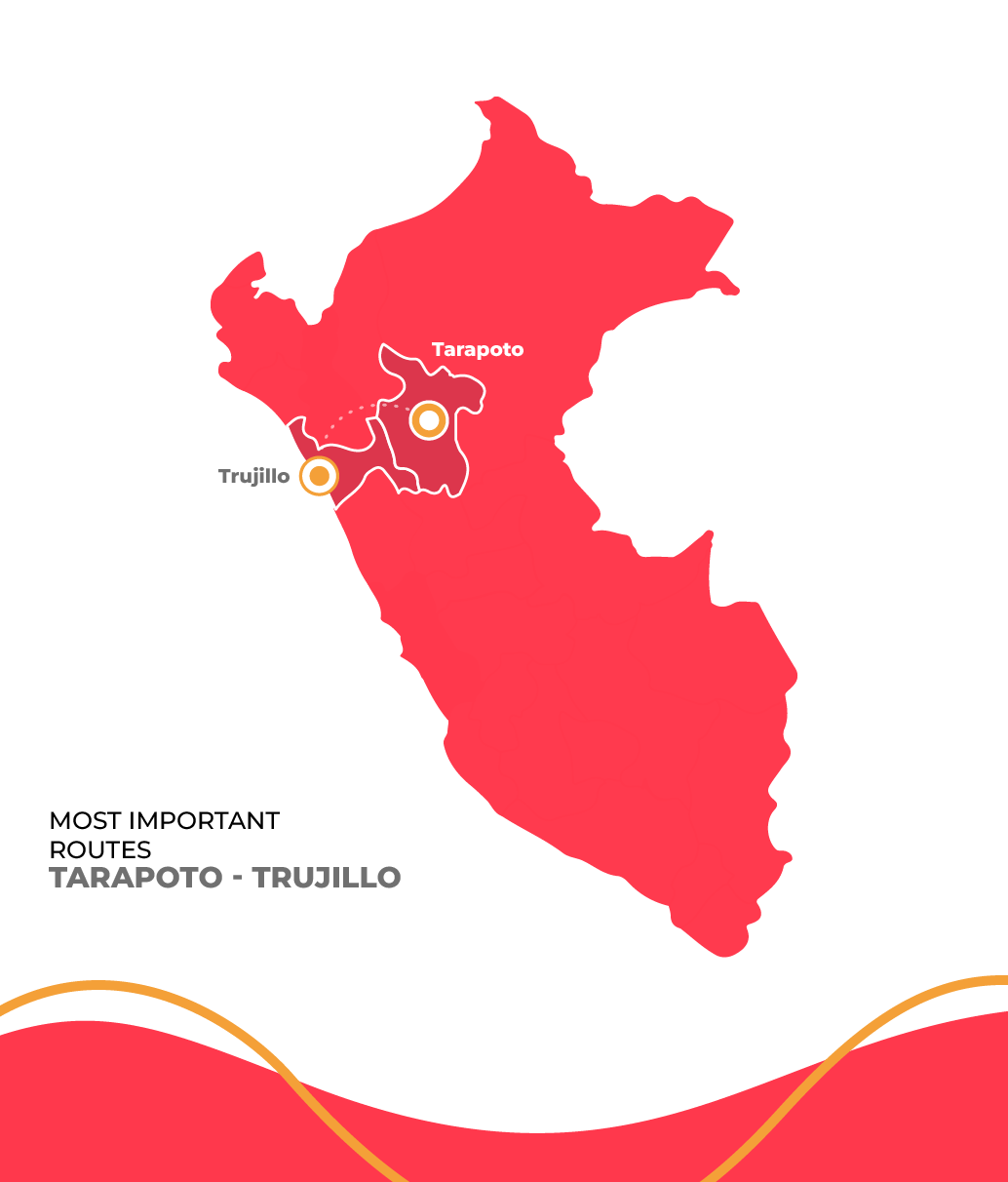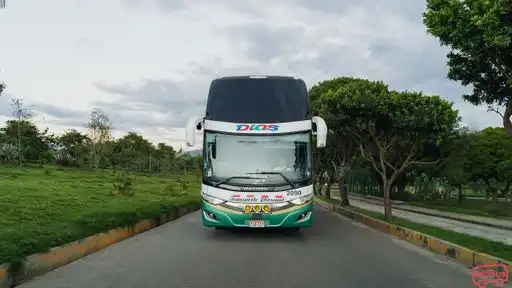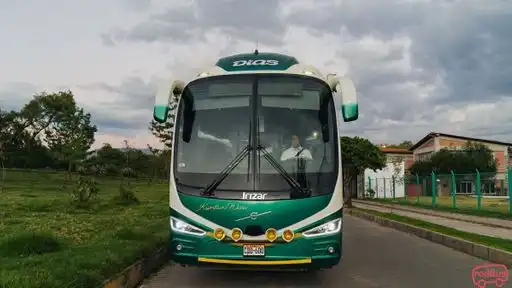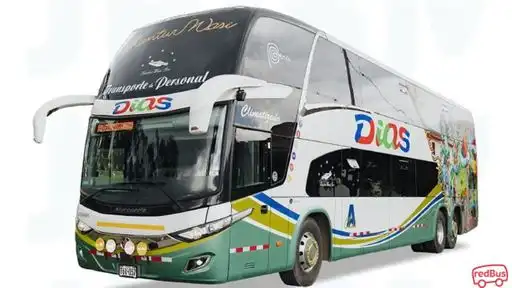Tarapoto to Trujillo Bus
OUR PROMISE
SECURE PAYMENT
redBus has secure payments and keeps your information and purchases completely safe and secure.
ATTRACTIVE DEALS
Get amazing discounts every time you book with redBus
WIDE CHOICE OF BUSES
150+ Bus companies with 800+ Routes in Perú
Tarapoto to Trujillo Bus Service
Avg. Bus Duration
:17 hrs 30 mins
Buses depart from
:Tarapoto
Bus arrives in
:Trujillo
Cheapest Bus
:PEN 120.00
Bus Companies
:1
Earliest Bus
:15:00
Last Bus
:15:00
Daily Bus Services
:1
Tarapoto to Trujillo Bus Timings & Fare
| Bus Operator | First Bus | Last Bus | Duration | |
|---|---|---|---|---|
| GH Bus | First Bus - 14:01 | Last Bus - 14:01 | 18 hrs 0 mins | VIEW PRICE |
Buy Tarapoto to Trujillo Bus Tickets Online - Unlock Extra Savings with redDeals on redBus
Tarapoto to Trujillo by Bus
The route from Tarapoto to Trujillo is at a distance of 514 mi (827 km) and it takes about 30 hours on the highway. The climate in Trujillo is nice, semi-warm and humid with lacking rains. Trujillo presents a minimum temperature of 57 °F (14 °C) and a maximum of 86 °F (30 °C).

Top Bus Operator Images



OTHER BOARDING & DROPPING POINTS IN
Tarapoto
- TARAPOTO
Trujillo
- Av Pablo Casals
Why book a Tarapoto to Trujillo bus with redBus?
You can also time-to-time redBus offers while booking your bus tickets online from Tarapoto to Trujillo. Follow a simple, fast and secure bus booking procedure. This helps save time and also helps to create a joyful travel experience!
About Tarapoto
The city was founded in August the 20th 1782 by the Spanish bishop Baltazar Jaime Martinez de Compagnon y Bujanda.In the Suchiche lagoon there was abundant palm tree called Taraputus or barriguda, the name that the bishop took to found the city of Tarapoto.From September the 14th 1906 the city began to be part of the San Martin department, fact that has allowed a great tourist and commercial development.
Climate in Trujillo:
- Summer (December to March): Temperatures can reach up to 30°C, with an average around 24°C. This season is dry, with very little precipitation.
- Winter (June to September): Temperatures drop slightly, with lows reaching around 15°C. The city often experiences fog and light drizzle, locally known as "garúa."
- Rainfall: Trujillo receives very little rain throughout the year, with an annual average of less than 10 mm, mainly concentrated during winter.
- Humidity: The humidity is high year-round, especially in winter, which can make temperatures feel cooler. This mild and pleasant climate makes Trujillo an ideal destination to visit at any time of the year.
Hotels in Trujillo:
- Gran Hotel El Golf de Trujillo
Location: 15 minutes from downtown, in a residential area.
Services: Pool, gym, spa, restaurants, and convention center.
Cost: From $120 per night. - Hotel Libertador Trujillo
Location: Trujillo’s Plaza de Armas.
Services: Pool, gourmet restaurant, bar, gym, and business center.
Cost: From $140 per night. - Hotel Gran Marquez
Location: Central area of Trujillo.
Services: Restaurant, bar, pool, and event rooms.
Cost: From $90 per night. - Hotel El Brujo
Location: Near the historic center.
Services: Breakfast included, restaurant, and internet access.
Cost: From $60 per night.
Restaurants and Bars in Trujillo
- El Mochica
Location: Av. Nicolás de Piérola 558, Trujillo.
Specialties: Traditional Peruvian cuisine, emphasizing criollo dishes and seafood. Known for its cozy atmosphere and authenticity in preparing northern Peruvian dishes.
Price range: $$ - $$$ - Squalo's
Location: Av. Larco 1150, Trujillo.
Specialties: Seafood and Peruvian-Latin fusion cuisine, popular among locals and tourists for its freshness and creative presentations.
Price range: $$ - $$$ - Chelsea Pub Restaurant
Location: Jr. Pizarro 691, Trujillo.
Ambiance: A popular spot for its relaxed atmosphere, cocktails, and a good selection of light dishes and seafood.
Price range: $$ - $$$ - AMA Disco Lounge
Location: Av. Larco 728, Trujillo.
Ambiance: A modern bar with live music and DJs, known as a nightlife hotspot in Trujillo.
Price range: $$ - $$$
Tourist Attractions in Trujillo
- Chan Chan: The largest adobe city in the Americas and former capital of the Chimú Kingdom, located a few kilometers from Trujillo.
- Huacas del Sol y de la Luna: An archaeological complex from the Moche culture, located in the Moche Valley, 5 km south of Trujillo.
- Huanchaco Beach: Famous for "caballitos de totora," traditional reed boats used by local fishermen. Ideal for surfing and enjoying seafood.
- Plaza de Armas of Trujillo: The historic center surrounded by colonial buildings, like the Trujillo Cathedral.
- El Brujo Archaeological Complex: Located in Magdalena de Cao, 60 km from Trujillo, known for the discovery of the Señora de Cao mummy, revealing much about Moche culture.
Important Dates in Trujillo
- International Marinera Festival (January): Trujillo is known as the "Capital of the Marinera," celebrating this traditional Peruvian dance with competitions and parades.
- Huanchaco Carnival (February): Held at Huanchaco Beach with floats, costume contests, and the crowning of a carnival queen.
- Holy Week (March/April): Religious processions in the historic center, especially at the Trujillo Cathedral.
- Anniversary of Trujillo’s Foundation (March 5): Celebrates the city's founding in 1535 with parades, cultural events, and festivities at Plaza de Armas.
How to Move Around Trujillo?
- Taxis: Readily available, offering a convenient and safe way to get around. It's recommended to use mobile apps or registered taxis.
- Buses and minibuses: Affordable public transportation connecting various parts of the city, though slower during peak hours.
- Mototaxis: Mainly used in peripheral areas or for short trips; they are a quick and economical option.
- Car Rentals: Several rental agencies provide vehicles, ideal for exploring Trujillo's surroundings and archaeological sites.
Typical Dishes and Drinks in Trujillo
These dishes and drinks are a key part of Trujillo's culinary identity, offering a unique gastronomic experience that reflects the region's rich cultural and historical heritage.
- Shambar: A thick soup traditionally eaten on Mondays, made with wheat, beans, pork, beef, smoked ham, and aromatic herbs, served with roasted corn.
- Sopa Teóloga: A hearty chicken soup with soaked bread, cheese, milk, and herbs like oregano.
- Goat Stew with Beans: Marinated goat meat cooked slowly and served with beans and rice.
- Ceviche: Trujillo’s version is known for its freshness, using fish marinated in lime juice with chili, red onions, and cilantro.
- Frejol Colado: A dessert made from pureed beans, sugar, cloves, and cinnamon.
- Chicha de Jora: A fermented corn drink with deep historical roots among the Moche and Chimú cultures.
What to Buy in Trujillo
- Moche and Chimú Ceramics: Replica pottery, like huaco portraits and decorative figures, are popular among tourists.
- Textiles and Ponchos: Handmade wool and cotton products, including ponchos, blankets, and traditional hats.
- Miniature "Caballitos de Totora": Replicas of traditional reed boats used by Huanchaco fishermen.
- Artisanal Liquors: Locally produced pisco and wines with unique flavors from the region.
- Silver Jewelry: Renowned for craftsmanship, especially with designs inspired by pre-Columbian cultures.
How to Get to Trujillo from Tarapoto by Bus?
The route from Tarapoto to Trujillo by bus covers approximately 1,150 km with a travel time ranging between 20 to 24 hours, depending on stops and traffic.
Bus Operators on the Tarapoto to Trujillo Route:
Turismo Dias
Boarding terminals in Tarapoto:
Tarapoto Terminal
Drop-off terminals in Trujillo:
Trujillo Terminal: Urb San Fernando, Av. Pablo Casals 110
About Trujillo
Trujillo was founded in 1534 by Diego de Almagro, under the name “Villa of Truxillo”. With the passing of time Trujillo would consolidate as one of the most important cities of the Peruvian viceroyalty, for being an administrative and commercial center, essential for the colonial system. During the independence period, Trujillo had a relevant role on Peru’s Independence, what gave the surname of “Ciudad Benemérita y Fidelísima a la Patria” (“Meritorious city and Faithful to the Homeland”). Besides that, it was the first city to break free from Spain. During the 19th century, and later that the Moche and Chicama valleys emerged as settlements of the sugar industry and the economy grew, new residents came to the city; mostly were european immigrants, what contributed to the development of a local esthetic, since the constructions took breathing from the neoclassical style.